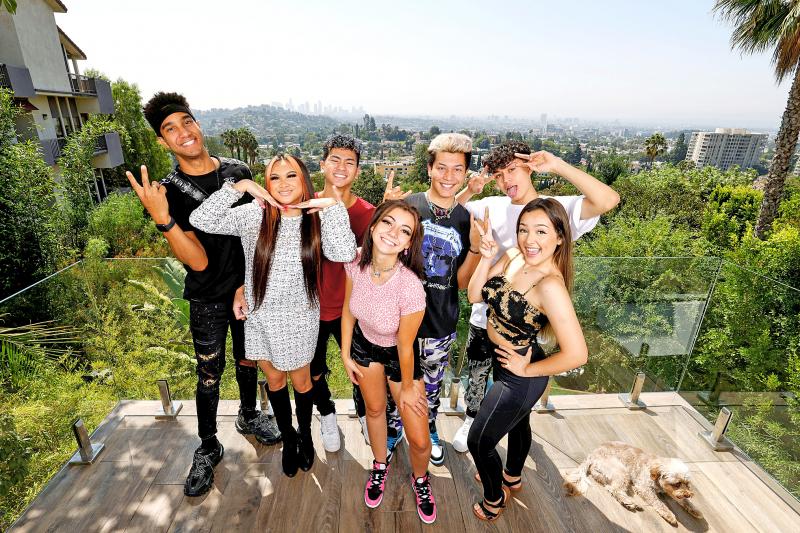The 22-year-old woman partially submerged in a bath of milk and flower petals slowly removes the mask obscuring her face. In doing so, Eloise Fouladgar revealed she was a resident of Britain’s latest so-called TikTok house to 53 million viewers.
It was a typically lavish “reveal” clip — a common promotional video used by teenage and twenty-something creators to announce they’ve moved into luxury multi-million-dollar mansions to make content for social media platforms, and promote brands for the marketing agencies that are picking up the bills.
It’s an all-expenses paid arrangement that sees savvy agencies lease aspirational homes on behalf of young creators with existing fan bases. The luxury pads are filled with branded goods, food and drink, cameras and, on request, helicopters, snakes or whatever else might lead a doomscroller to pause for 15 seconds.

Photo: Reuters
Pioneered in the US, British real estate is being snapped up by marketing agencies who want to replicate the successes of their American peers as TikTok rises to prominence to become the social network of choice for fans of short-form videos of dance routines, goofy comedy and pranks.
The trend on UK soil started with agency Fanbyte’s central London Bytehouse in March, and was followed by Yoke Network’s Essex county Wave House in September, and WeRmedia’s multi-million-dollar west London Icon House last month. It isn’t all spa days and fun, however.
“It may look like they are just there enjoying a lavish lifestyle, but the reality couldn’t be further from the truth,” said Kelly Levi, who along with Elad Panker co-founded WeRmedia in October last year. “Working and living under the same roof 24/7 can be challenging.”
The original Hype House in Los Angeles is often used as a blueprint, having played home to TikTok stars like Charli D’Amelio and Addison Rae. Both young women became major celebrities, taking the top two spots in a Forbes assessment of TikTok’s highest earners last year. Rae topped the list with an estimated US$5 million.
“If each of our creators can aim to do anywhere near that over the next 12 months, we will all be very happy,” said Levi.
The influencer advertising market may be worth as much as US$10 billion this year, according to marketing firm Mediakix. Data compiled by Influencer Marketing Hub suggested a figure of US$9.7 billion. And Bytedance’s TikTok, while still catching up to Instagram and fighting off a potential ban by the US government, generated more than US$3 billion of net profit on US$17 billion in revenue last year.
Influencers with large fan bases tend to make their money from brands who pay them to create posts about their products. Creator houses are an evolution of this model, with agencies underwriting living costs and attracting sponsors.
In return, their affiliated influencers continually churn out viral videos that can incorporate client products and expose them to millions of potential consumers. As book deal or offers of TV jobs roll in, those agencies are on hand to take a cut of the takings, too.
Timothy Armoo, the 25-year-old chief executive officer of Fanbytes, the agency behind Bytehouse, added that his UK “Bytesquad” influencers can “comfortably make high five-figure or six-figure” sums on brand deals and endorsements.
The group was among the first to move into a TikTok house in the UK and comprises six creators aged between 17 and 21 years. Videos from the central London residence have racked up more than 50 million likes. The creators have also amassed large individual followings — Sebby Jon and KT Franklin securing 2.8 million and 2.3 million followers respectively.
Since launching in March, the group has worked with companies such as Samsung Electronics and Huawei Technologies, as well as the UK government on its public health campaign during the pandemic, Armoo said. A cut from such deals goes to Fanbytes, although the CEO wouldn’t say what the split was between creator and agency.
The Wave House opened next. The sprawling £5 million (US$6.5 million) mansion is now home to the milk-bathing Fouladgar, as well as five other creators aged 20 to 22 years. The agency behind them, Yoke Network, was founded by 26-year-old CEO Jide Maduako, who said he wants to build his brand into “the Disney of TikTok,” referring to Disney Channel celebrities of the early noughties such as Miley Cyrus.
The University of Lancaster business graduate founded Yoke in 2018 with school friend Mustafa Mohamed, and said he took inspiration from his time as an ex-professional soccer player for Leicester City as a teenager.
“All you had to do was focus on football and be the best that you could be,” Maduako said.
Whether bathing in milk under a bejewelled mask was also drawn from his sports background was left unmentioned.

Not long into Mistress Dispeller, a quietly jaw-dropping new documentary from director Elizabeth Lo, the film’s eponymous character lays out her thesis for ridding marriages of troublesome extra lovers. “When someone becomes a mistress,” she says, “it’s because they feel they don’t deserve complete love. She’s the one who needs our help the most.” Wang Zhenxi, a mistress dispeller based in north-central China’s Henan province, is one of a growing number of self-styled professionals who earn a living by intervening in people’s marriages — to “dispel” them of intruders. “I was looking for a love story set in China,” says Lo,

It was on his honeymoon in Kuala Lumpur, looking out of his hotel window at the silvery points of the world’s tallest twin skyscrapers, that Frank decided it was time to become taller. He had recently confessed to his new wife how much his height had bothered him since he was a teenager. As a man dedicated to self-improvement, Frank wanted to take action. He picked up the phone, called a clinic in Turkey that specializes in leg lengthening surgery — and made a booking. “I had a lot of second thoughts — at the end of the day, someone’s going

In the next few months tough decisions will need to be made by the Taiwan People’s Party (TPP) and their pan-blue allies in the Chinese Nationalist Party (KMT). It will reveal just how real their alliance is with actual power at stake. Party founder Ko Wen-je (柯文哲) faced these tough questions, which we explored in part one of this series, “Ko Wen-je, the KMT’s prickly ally,” (Aug. 16, page 12). Ko was open to cooperation, but on his terms. He openly fretted about being “swallowed up” by the KMT, and was keenly aware of the experience of the People’s First Party

Standing on top of a small mountain, Kim Seung-ho gazes out over an expanse of paddy fields glowing in their autumn gold, the ripening grains swaying gently in the wind. In the distance, North Korea stretches beyond the horizon. “It’s so peaceful,” says the director of the DMZ Ecology Research Institute. “Over there, it used to be an artillery range, but since they stopped firing, the nature has become so beautiful.” The land before him is the demilitarized zone, or DMZ, a strip of land that runs across the Korean peninsula, dividing North and South Korea roughly along the 38th parallel north. This